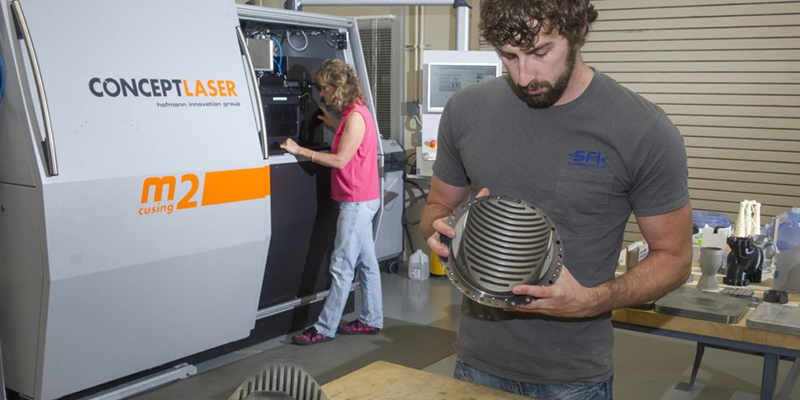
(Photo: Picryl)
However the Los Angeles Basin’s manufacturing sector fares post-COVID-19, one thing is clear. The region’s community colleges will play a significant role in providing employers with a trained, middle-skill workforce.
The region is a vibrant hub for manufacturing that offers well-paying career opportunities for students attending the area’s community colleges. These are not your parents’ manufacturing jobs, as they include new technologies that extend to markets around the globe.
A new report released by the Center for a Competitive Workforce, a partnership between the Los Angeles Economic Development Corporation and LA19, a group of the region’s 19 community colleges, projects strong employment opportunities for middle-income manufacturing jobs between 2018-2022. (The report was prepared before the COVID-19 economic disruptions.)
“It’s also an industry that’s been undergoing its own transformation, transitioning from more labor-intensive processes and production skills to more specialized and multi-functional high-tech skills to adapt to more significant industrial disruption that has long been taking place,” said Shannon Sedgwick, director of the LAEDC Institute for Applied Economics.
She outlined the transformation that has been driven by three phenomena:
- Advances in material sciences, broadening the number of potential inputs into manufacturing exponentially
- The explosion in computing power and memory, infusing advanced technologies, i.e. robots, AI, into manufacturing
- Globalization, opening new markets, expanding supply chains and reducing costs
The manufacturing sector in the Basin, which includes Orange County, employs more than 420,000 workers, and pays higher average wages compared to the combined average of all industries in the region. With a retirements and employment churn (turnover), it was predicted about 150,000 middle-skilled job openings would be created in the region’s manufacturing sector over a five-year period. Of those, 2,300 would be net new jobs.
As manufacturing work moves away from repetitive tasks classified as low-skilled, the requirements for employment in this sector will change. Forty-three percent of the projected openings in manufacturing over the next five years will be in middle-skill occupations.
“That reinforces selection of the industry as a valid target for community college programs,” added Sedgwick. She said job seekers who have completed post-secondary, non-degree career education programs have good job prospects in the region’s manufacturing sector.
The middle-skilled jobs predicted with the fastest growth over the next five years include: Avionics Technicians, Ophthalmic Technicians, Molders/Shapers/Casters (excluding metal and plastic) and Medical Equipment Repairers.
The report makes the following recommendations to ensure there are enough middle-skilled workers to fill the region’s manufacturing worker shortage:
- Workforce Training is Still Needed
- The speed of innovation demands that industry be involved in developing appropriate training programs and in forming partnerships with learning centers and colleges so that candidates are job-ready for available occupations.
- Impending Worker Shortage
- Community colleges may need to be calibrated to meet forecasted demand. This may involve targeting programs where there is little demand and focusing on programs with a high demand for workers.
- Apprenticeships
- The manufacturing industry would benefit from increased apprenticeships, as skilled workers transfer their knowledge and skill in the trade to trainees on-the-job, creating a pipeline of qualified workers.
As the economic climate has changed in the wake of the COVID-19 pandemic, so has the outlook for manufacturing in the region. “At this time, we don’t definitively know how COVID-19 is going to impact the industry or for how long. But we can speculate what might occur,” said Sedgwick. In Los Angeles County, 61 percent of manufacturing employers are “micro-businesses” (less than 10 employees). These microbusinesses provide roughly 25,000 payroll jobs and 25,000 jobs are with manufacturers with 10-19 employees.
She added, “Some manufacturing industries may actually experience faster growth than we originally forecast, for example, bio-medical manufacturing may grow at a faster rate than we expected as companies work on a vaccine or produce PPE that’s in short supply.” She also pointed to the vulnerable global supply chains that were disrupted and could lead to more onshoring to increase local supply chains.
On an optimistic note, Sedgwick said, “Consumer behavior may change and impact consumption and therefore growth.” But, also noted, “Households may increase their rate of savings and reduce their consumption in an attempt to be less vulnerable to shocks in the future.”
Two priorities of the 2020 Roadmap of the California Economic Summit, produced by CA Fwd and the California Stewardship Network, are helping create regional workforce collaboratives that connect education institutions with employers and also working with the Newsom Administration to establish a California Sustainable Manufacturing Council to help create policies that support manufacturing ecosystems across the the state's distinct regional economies.

